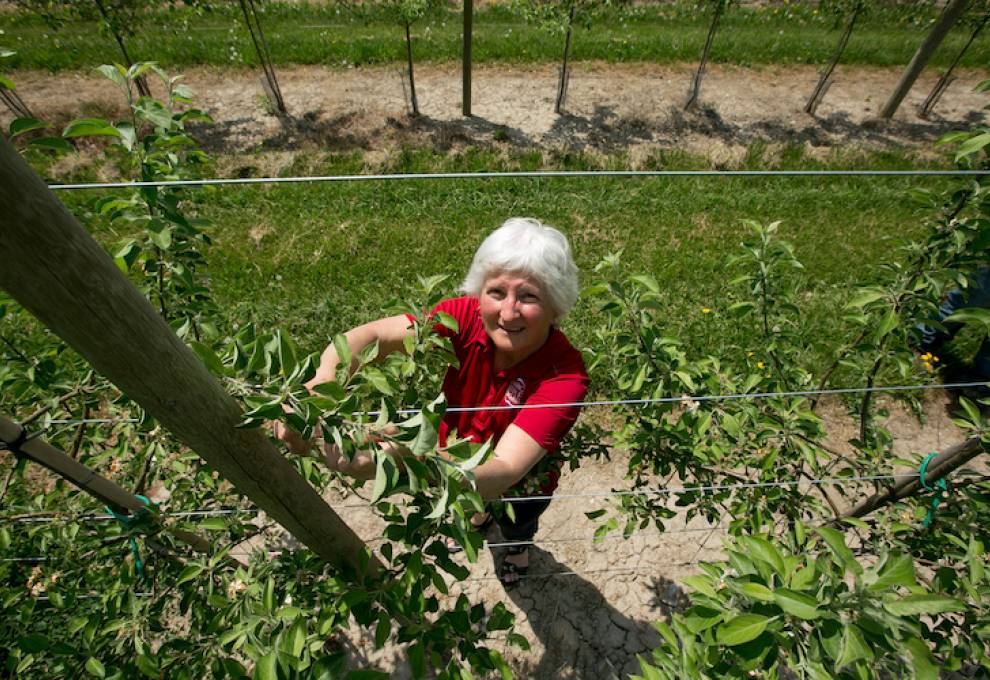
One out of every 10 apples exported by Washington state gets crunched in Canada. That’s a formidable competitor for a country whose tradition of apples harkens back to 1633 in Nova Scotia’s Annapolis Valley. The French settlers called the original apple the Fameuse. The English called it Snow.
Centuries later, apple breeding continues its noble path in Canada. A new Canadian Apple Breeding Consortium is coalescing with $4.2 million in federal funding. Rather than search for the next blockbuster to compete against Washington, Canadian researchers are pursuing several varieties that might work in different areas of the country. Take note. There are many microclimates within six apple-growing provinces: British Columbia, Ontario, Quebec, New Brunswick, Nova Scotia and Prince Edward Island.
“It’s still early days,” says Dr. Daryl Somers, research director for applied genomics at Vineland Research and Innovation Centre, Ontario, putting into context the long haul of apple breeding. “2019 represents the eighth season of orchard work and tree evaluation at Vineland. We’re getting a better understanding of the architecture of trees and yields.”
Somers points to the input of apple grower Cathy McKay, vice-chair of the Ontario Apple Growers and chair of the research committee. “She’s been a real champion of our work, keeping us grounded from a grower’s perspective.”
For decades, McKay has nurtured her 27-acre orchard called Nature’s Bounty near Port Perry, Ontario. She has also adapted in recent years with conversion to high-density orchards and varieties that will draw consumers to the rolling hills of her scenic farm.
Of all her talents, the one that’s least known is her contribution to both provincial and national research groups. She’s done a stint as a director on the Summerland Varieties Corporation (previously PICO) whose mission is to identify and commercialize new tree fruit varieties. Her eight years on that board have sharpened her awareness about the goals of a complex breeding program.
“This Canadian program gives growers the opportunity to become connected on the numbered varieties that have potential for the future,” says McKay. “Summerland has a variety that’s been fast tracked in the release program because of its good flavour, texture and disease resistance. It can work in geographies where it rains a lot.”
This multi-pronged approach is appreciated by Vineland’s Dr. Somers who will be working closely with Dr. Amritpal Singh at Ag Canada’s Summerland Research Centre in British Columbia as well as Dr. Sean Myles at Dalhousie University, Nova Scotia. Together, they are developing molecular techniques to identify traits of interest in young plants. Imagine not needing years of breeding research because they can determine if an apple tree will produce crisp fruit before it is even old enough to flower.
Growers have an important role in the research continuum. A national grower testing program minimizes the risk to fellow growers by demonstrating that a new variety can be successfully grown throughout the country.
“It’s important that the variety will retain premium quality throughout commercial storage, pack and retail display and that the variety has enough consumer appeal that people will choose it over other commercial varieties,” says Erin Wallich, research and development manager for Summerland Varieties Corporation.
On the face of it, a business strategy to use pan-Canadian resources to produce several local varieties sounds surprising. Dig deeper, and it’s a very perceptive strategy in playing to strengths while countering global imports.
McKay points out that diverse micro-climates are a strength for the Canadian apple industry. If one area suffers a weather setback, then other areas can fill the production gap.
“A lot of investment is going into the apple industry,” notes McKay. “It’s in establishing new orchards, new trellis systems and new varieties. We have a very active group of young growers here in Ontario.”
The local food movement has lifted the Ontario industry with about 45 per cent of apple production sold directly to consumers. Another strength is proximity to the large consumer market of the Greater Toronto Area.
Every province has its unique set of growing and marketing climates. But growers have proven to be resilient. The Canadian apple industry posted its first increase in acreage in decades -- in 2016. Apple breeding research is a cornerstone in keeping the storied history of Canadian apples alive.
Karen Davidson, editor of The Grower, goes 'Behind the Scenes' of this story in a podcast with apple grower Cathy McKay (Click here to listen). Cathy shares her excitement about the potential for new varieties from the Canadian Apple Breeding Consortium.

Add new comment